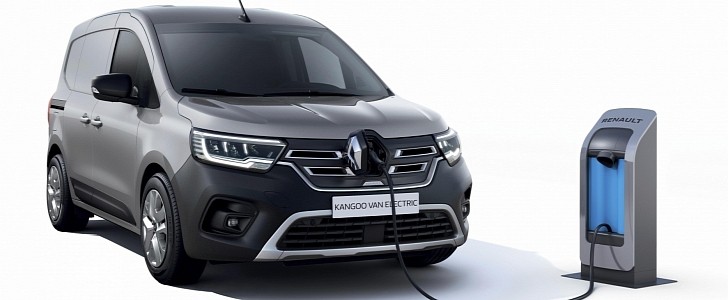Transporting heavy loads is not something BEV (battery electric vehicles) have proved to deal well with so far. The massive battery pack they have to carry and the long times required to charge them will be a hindrance compared to FCEVs (fuel cell electric vehicles). On the other hand, small commercial vehicles will do just fine, as Renault proves with the new-generation Kangoo Van E-Tech.
The new van now presents a 45-kWh battery pack, more than double the Kangoo Z.E., which featured a 22-kWh unit. The benefits were also extended to the electric motor, which is more than twice as potent as its predecessor. While the Kangoo Z.E. had a 44 kW (59 hp) motor, the Van E-Tech has one that delivers 90 kW (121 hp).
Despite the two-fold improvements, that did not apply to the range. Instead of 170 kilometers (107 miles) of range under the NEDC cycle, it now presents 300 km (186 mi) of range, only under a more severe testing cycle: WLTP. We suspect the lower number than expected has to do with the testing method and the third-generation Kangoo being slightly larger (and heavier).
Renault has been a pioneer in using heat pumps in electric vehicles – with the ZOE – and the new Kangoo Van E-Tech is no exception. Renault says it extracts heat from “the air around the vehicle” without using energy in an electrical resistor. The company also said that the heat pump works best between -15ºC (-17.22ºF) and 15ºC (59ºF).
The Kangoo Van E-Tech has an 11-kW three-phase onboard charger as standard. Optionally, customers can order a 22-kW charger that may recover 170 km (106 mi) of range in 30 minutes when the van uses an 80-kW fast charger. Renault informs that the optional charger gives the battery pack “liquid cooling capabilities.”
In other words, the battery pack is ordinarily air-cooled, just like it is on the Nissan Leaf and the Renault ZOE. Considering air-cooled battery packs tend to have a shorter lifespan, this is probably a wise investment, regardless of needing fast charging or not.
Anyone driving the new Kangoo electric will be able to select three regenerative braking levels: Sailing (for motorways and fast lanes), Drive (with more regenerative braking), and Brake (for one-pedal driving and maximum regeneration). Sadly, they will only manage to select them by spring 2022, when Renault plans to start deliveries.
Despite the two-fold improvements, that did not apply to the range. Instead of 170 kilometers (107 miles) of range under the NEDC cycle, it now presents 300 km (186 mi) of range, only under a more severe testing cycle: WLTP. We suspect the lower number than expected has to do with the testing method and the third-generation Kangoo being slightly larger (and heavier).
Renault has been a pioneer in using heat pumps in electric vehicles – with the ZOE – and the new Kangoo Van E-Tech is no exception. Renault says it extracts heat from “the air around the vehicle” without using energy in an electrical resistor. The company also said that the heat pump works best between -15ºC (-17.22ºF) and 15ºC (59ºF).
The Kangoo Van E-Tech has an 11-kW three-phase onboard charger as standard. Optionally, customers can order a 22-kW charger that may recover 170 km (106 mi) of range in 30 minutes when the van uses an 80-kW fast charger. Renault informs that the optional charger gives the battery pack “liquid cooling capabilities.”
In other words, the battery pack is ordinarily air-cooled, just like it is on the Nissan Leaf and the Renault ZOE. Considering air-cooled battery packs tend to have a shorter lifespan, this is probably a wise investment, regardless of needing fast charging or not.
Anyone driving the new Kangoo electric will be able to select three regenerative braking levels: Sailing (for motorways and fast lanes), Drive (with more regenerative braking), and Brake (for one-pedal driving and maximum regeneration). Sadly, they will only manage to select them by spring 2022, when Renault plans to start deliveries.









